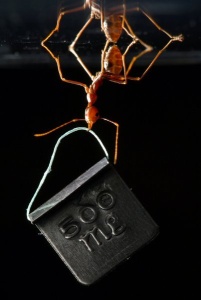 Source
Source
Rex Kerr's answer has linked to photographic evidence of an Asian Weaver ant lifting 100 times its bodyweight (no, it's not the one above).
The picture won first prize in the first Biotechnology and Biological Sciences Research Council science photo competition.
To me the amazing thing is that the ant is actually clinging upside-down to a smooth surface while lifting that 500mg weight:
 Source
Source
But,
ants are actually not stronger than humans.
The reason why ants can lift so much is due to scaling, meaning it has to do with math, not muscles.
Strength:
The strength of a muscle scales with
the cross-sectional area. (Exercise makes a muscle bigger, but not longer)
 Source
Source
This means, the strength of an organism increases
as the square of the scale factor.
Mass:
The mass of an object depends on its
volume.

 Source
Source
The spider on the right is 3x the size of the small spider, but it weighs 27x as much.
The weight of an object increases as
the cube of the scale factor (33=27)
Mass increases faster than strength.
 Source
Source
So, if an ant would be human size
it wouldn't be able to lift 100x
its bodyweight anymore.
Or going the other way, playing
"Honey I Shrunk the Kids":
 Source
Source
ant size humans would be as strong as ants.
Sources:








